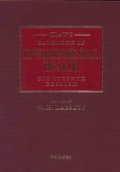This text focuses on the techniques used to assess the bioavailability and bioaccessibility of metals and persistent organic pollutants in environmental samples. The opening chapter considers the link between human health and contaminated land. Then, the different sample preparation techniques applied to solid and liquid samples for elemental analysis are discussed – in particular, the need to destroy the matrix by heat and/or acid(s) for solid samples whereas in the case of liquids the emphasis is on pre–concentration and/or separation of metals from solution. The book continues to evaluate the different sample preparation techniques applied to solid and liquid samples for persistent organic pollutant analysis. Consideration is then focused on the different sample preparation techniques applied for single and sequential extraction of metals from soils and sediments. Chapter 5 evaluates the different sample preparation techniques for non–exhaustive extraction (cyclodextrin, supercritical–fluid extraction, subcritical water extraction, solid–phase microextraction and membrane separations) of persistent organic pollutants from soils and sediments. In addition, a mathematical approach to predict weak and strong solvents, based on the Hildebrand solubility parameter, is proposed. In Chapter 6, the different techniques for assessing the oral bioaccessibility of metals and persistent organic pollutants from solid environmental samples are considered. The penultimate chapter presents four case studies taken from the author’s own laboratory, as follows: The first of these considers the uptake of metals (Cd, Cu, Mn, Pb and Zn) by plants grown in compost under greenhouse conditions. The second considers the oral bioaccessibility of metals (Cd, Cu, Mn, Pb and Zn) from plants grown on contaminated compost using an in vitro gastrointestinal extraction approach. Case study three discusses the uptake of persistent organic pollutants (a–endosufan, b–endosulfan and endosulfan sulfate) by lettuce plants grown in compost. Finally, case study four looks at the oral bioaccessibility of persistent organic pollutants by lettuce plants grown in compost using an in vitro gastrointestinal extraction approach. This book also contains a useful collection of data sheets that could be used to record laboratory information at the time of carrying out the experiments, plus a guide to selected resources. This text will be suitable for those carrying out undergraduate courses in environmental science, as well as courses in related disciplines, e.g. chemistry, life sciences, etc. It will also be relevant for postgraduate training courses, including MSc and MRes in environmental science and related disciplines and for researchers interested in the bioavailability and associated features of environmental contaminants. The Analytical Techniques in the Sciences series of books provides coverage of all of the major analytical techniques and their application in the most important areas of physical, life and materials science. Each text is presented in an open learning/distance learning style, in which the learning objectives are clearly identified. The reader’s understanding of the material is constantly evaluated by the use of self–assessment and discussion questions. Series Editor: David J. Ando
